
Balancing Act: Incentives, Short-Termism, and Strategic Investments
January 16, 2021
List of 148+ COVID-19 Dissertation Topics | Discover Ideas for Your Research
January 19, 2021 Download PDF File
Download PDF File
The primary aim of the study was to find out the impact of brand love on consumer buying behaviour in dietary supplements in the region of the UK.
The text pertains to the study's abstract.
ABSTRACT
The data is collected with the help of primary sources to attain the aim of the study systematically.
Particularly the data is collected with the help of a survey questionnaire to collect relevant information from 200 respondents belonging from the region of the UK in a small period.
The data collected is analysed with the help of the statistical software of SPSS.
Correlation analysis, regression analysis and descriptive analysis have been used by the researcher to analyse and evaluate the data efficiently.
Impact of Social Media Marketing on Consumer Buying Behaviour
The findings of the research show that there is a strong impact of the independent variable on the dependent variable of the research. The results show that brand love has a significant impact on consumer buying behaviour in dietary supplements in the region of the UK.
The factors which are identified with the help of past literature are; Variety seeking, brand image, Social self, brand loyalty, and word-of-mouth communication. All these factors are the ones that add up to constitute the concept of brand love.
CHAPTER ONE: INTRODUCTION
The following text comprises the introduction of the study.
-
Introduction
The potential problem that the organizations were facing in the dietary supplement sector included that the consumers who were loyal and satisfied were not considered long-term loyal consumers for the brand and there is a chance that the consumer may switch the brand.
-
Rationale
According to Sarkar (2014: 481), Brand love is considered an emerging concept and needs to be explored. Literature has been conducted in detail on brand loyalty and word-of-mouth communications but the literature on brand love and its association to the dietary supplement sector was found to be limited.
Luxury Marketing and Branding- An Evaluation under BLI (Brand Luxury Index)
Due to the increasing number of brands customers were found switching from one brand to another and the increased ageing and healthcare costs were demanding dietary supplements that appeared nutritious in context.
According to Research and Market (2017), the dietary supplement industry was growing at its peak, but there was a need to identify what were the factors that influence the behaviour of the consumers in the dietary supplement sector of the UK and what were the factors that were causing the consumer to buy the products in association to the brand love.
-
Research Questions
Below are the research questions:
- What is the concept of brand love and consumer buying behaviour?
- What are the factors associated with brand love and consumer buying behaviour?
- What is the impact of brand love on consumer buying behaviour in the dietary sector of the UK?
- What are the possible ways to increase the influence of brand love on consumer buying behaviour in the dietary sector of the UK?
Chapter two is inclusive of a detailed literature review on the topic of brand love.
CHAPTER TWO: LITERATURE REVIEW
Chapter two includes the concept of brand love, theoretical framework, conceptual framework, the role of brand love in consumer-brand relationships, and antecedents and consequences of brand love.
Factors affecting brand love are also discussed in the literature review.
-
Fast Moving Products Related to FMCG and Dietary Supplements
According to Vanelslander, Deke and Van Hove (2013: 243), fast-moving consumer goods or consumer packaged products are those that are sold quickly and mostly at a relatively lower cost. The fast-moving goods include non-durable goods including over-the-counter drugs, soft drinks and beverages, processed goods and many other consumer products.
According to Sarkar (2014: 481), consumers develop love related to specific brands and their fast-moving goods. They show loyalty and commitment towards the brands through repeat purchases.
The consumer's love towards the brand comes mostly from the possessions of emotional feelings with the brand and the feelings include pleasure, love and consumers' relationship with the brand.
When a consumer becomes satisfied with a specific brand for instance a soft drink flavour that he loves, based on satisfaction the repeat purchases to buy those products increase.
The consumers show their commitment and loyalty towards that specific brand and try to buy only that particular brand they love. Marketers are developing how to increase brand loyalty of FMCG products towards the consumer.
According to Albert and Merunka (2013: 258), one strong point for FMCG marketers is that FMCG products are inclusive of those goods and products that are a part of necessity and used daily.
There is a chance that the customer increases purchases both due to their needs and emotional attachment.
-
Branding and the Dietary Sector
According to one research, it was found that brand loyalty in the dietary sector appears to be higher which shows that branding has high power in the shortcut decision-making process for consumers (McAdam et al. 2014: 830).
When consumers are loyal to a brand the time to search is reduced and they easily buy a product and make choices. Supermarkets aimed at selling dietary and FMCG products realize the importance of branding and developing ways to increase brand loyalty among their consumers.
Evidence has shown that consumers prefer to buy branded food products and dietary supplements although in periods of recession, there are little material differences between the brand supplements of supermarkets and the branded food products (McAdam et al. 2014: 830). However, the dietary segment does not much focus on this fact.
-
Concept of Brand Love
According to Albert and Merunka (2013: 258), the concept of love is based on the interpersonal relationships between the brands but in the context of marketing, it goes beyond the interpersonal relationships.
The determinants of love include impulsive desire, and preeminent emotional contents in the context of consumers’ reactions towards their favourite brands. Psychology has emerged with different definitions of brand love and has been related to a variety of different phenomena and events.
According to Drennan (2015: 47), the individual interaction with the object shows the degree of emotional relationship. For instance, if an individual has a strong relationship with another person, for the strength of the relationship that individual would sacrifice for the favour of that person.
Likewise, when a consumer loves a certain brand and has a strong connection to it, will show his commitment towards that specific brand and make financial sacrifices to obtain that specific product.
According to Albert and Merunka (2013: 258), the concept of brand love appears like an exaggeration but in the more contemporary society, individuals are more devoted to material goods to justify attitudes and behaviours.
Marketing teams of the organizations have identified these facts and are now developing a focus to attract consumers towards their brands through effective sales strategy. Marketers are developing a focus on the development of amusement, desire or gratitude with preliminary benefits with the products so that they appear appealing to the customers and develop an emotional element with it.
Impact of Social Media Marketing on Consumer Buying Behaviour
As a result, the consumer becomes inclined towards that specific product/brand. This approach is termed the hedonist approach and the product is termed as the hedonist product.
Researchers investigated the consumer's love for tenure and it was found that the consumer’s feelings towards a brand were mainly based on the desire, love and consumer connection with the brand (McAdam et al. 2014: 830).
Evidence shows that the relationship between the consumers and the goods appears unidirectional (Kiuru 2014). Consumer shows immense affection and agitation towards consumption of the specific product and the object cannot yield the love or recruit a relationship. The rationale of consumer relationship is the marker of all types of relationships between consumers and the utilization of the products, services, advertisements etc.
According to Kiuru (2014), the triangular love theory stated by Stenberg is analogous to the “consumer of love objects” model. Following these theories, the consumer’s association with the brand may be categorised into three basic components including; fondness, desire and decision/conciliation. The three dimensions lead to the categorization of eight more types of consumer relationships inclusive of; liking, disliking, passion, functionalism, repressed desire, utilitarianism, capitulated desire and loyalty.
Brand love may be defined as the love a customer has towards the brand. Love is the emotional part of the relationship a consumer has with the brand. The customer in this situation is the satisfied one. Brand love is analogous to various concepts including; passion in association with the brand, personal attachment towards the brand, positive feelings and emotions with a brand linked and declarations of love towards the specific brand. Consumers respond loosely concerning the specific word “Love” about this category.
-
The Role of Brand Love in Consumer Brand Relationships
Empirical research was performed to understand the consumer's love towards the products or the activities associated with the consumption of the products. The researcher found that the consumer showed a strong preference towards the specific product. The author revealed an association between the interpersonal love a person has and the love for the consumer’s context.
Evidence has shown a relationship between the brand concept including hedonism of the product, self-expressiveness, loyalty to the brand and positive word-of-mouth communications. The hedonistic nature of the product was found associated with brand loyalty rather than the moderation of brand love and shows that it has a negative association with it. On the contrary, the direct association between self-expressiveness and positive word of mouth was considered to impact positively on the relation.
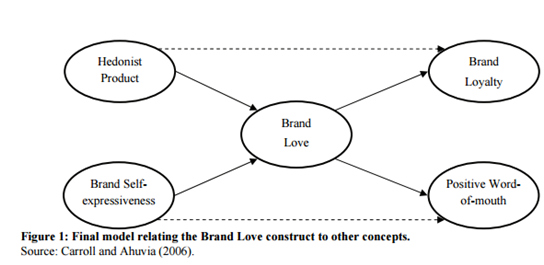
According to Carroll and Ahuvia (2013), empirical evidence shows the effectiveness of the brand love construction in evaluating the different responses of consumers in association with brand satisfaction. Brand love is found to be strategically associated with the development of physically powerful emotional associations with consumers.
According to Albert and Merunka (2013: 258), brand love and satisfaction of the brand are two different concepts. Brand love is considered part of brand satisfaction. This is a response experienced by the consumers loving a specific brand.
The satisfaction a consumer receives from a brand is a cognitive judgement; brand love is found to have a stronger effective focus. Brand love is an outcome of the long-term relationship a consumer has with a specific brand.
Brand satisfaction on the other hand is the specific outcome of the result of the operation. Brand love does not demand any expectation or confirmation but brand satisfaction is based on the paradigm of expectation confirmation.
The brand love concept in the perspectives of many authors is declared as “I love this brand” by the consumers and integrates the consumer's identity with a specific brand. The love for the brand concept is highly differentiated from the consumer’s influence of the brands including “I like this brand”. Brand love is considered an immense and strong response towards the brand rather than simply just liking it.
-
Antecedents of Brand Love
The antecedents of brand love include the following;
1. Brand Love and Satisfaction
According to Roy, Eshghi and Sarkar (2013: 325), satisfaction is considered an evaluative judgment after the brand product has been consumed. Brand satisfaction is not considered completely cognitive. The satisfaction associated with the brand leads to long-term attachment with the brand involving many interactions with the brand. It is representative of the cumulative interaction of the brands with the consumers.
2. Brand Experience and Brand Love
Brand love is presented as an attitude towards a brand. Brand love is considered greatly effective in context. The brand experience that appears positive and favourable increases the love of the brand over time.
3. Customer Delight and Brand Love
If the interaction between the brand and the consumer is perceived as positive, it is considered that the consumer feels delighted. This leads to a strong emotional bond between the brand and the consumer. The customer's delight may be described as a feeling of joy, pleasure and surprise in association with the consumption of a brand's product. Customer delight is expected to increase the love of the brand over time as it is already known that brand love has a strong affective focus.
4. Satisfaction and Customers Delight
According to Roy, Eshghi and Sarkar (2013: 325), there are two dimensions of satisfaction cognitive and affective. The affect dimension is considered part of customer delight. Satisfaction is considered an element of customer delight and both are experiences developed after the consumption of the product. Satisfaction is known to influence the customers to delight positively.
5. Individual Materialism and Brand Experiences
According to Albert and Merunka (2013: 258), a non-materialistic individual gets involved in the consumption of a product or service through experience. However, the materialistic one is not influenced by the experience and does not engage in consumption on this basis. These individuals buy these products to show off and enhance their social status. Materialism is found significantly associated with status consumption (Schmitt, Brakus and Zarantonello 2014: 727).
-
Theoretical Framework
Evidence shows theoretical studies conducted on brand love. According to the work of Anderson (2016), there exists an emotional bond between the consumer and the brand. According to the Triangular theory of love customer-object relationship was categorized into eight different stages differentiating them into three different components (Anderson 2016). These include;
Disliking: the feelings that are weaker in commitment and liking towards a brand may be considered as not liking. In this situation, customers do not have feelings of love towards the brand.
Explore the Relationship Between Reverse Logistics And Customer Satisfaction
Liking: Liking represents that consumers are somewhat close to the object. They like it and represent commitment towards a brand.
Infatuation: It is based on commitment and liking that appears to be weak. According to this concept, consumers prefer objects based on their functional properties and because they deal with the symbolic needs of the consumers.
Functionalism: Functionalism refers to a strong commitment towards the brand but with weak yearnings and likings. Consumers who make decisions towards the brands appear more rational rather than emotional. Their main focus here is the functionality of the brand.
Inhibited Desire: It is inclusive of infatuation and weak commitment. The consumers have some feelings of liking and passion towards the object but these feelings are concealed due to certain external factors and non-realizations of the buying process.
Utilitarianism: The utilitarian concept is inclusive of inhibited desire, commitment higher in strength and weak yearning. When the consumer buys the product through repeat purchase then the likeness toward the specific brand increases.
Succumbed Desire: This involves weak liking with strong commitment and passion. The consumers purchase the product due to their passion but they do not like the product.
Loyalty: Consumers are committed and loyal to the product with a strong passion. Due to their strong likeness consumers prefer to buy the brand.
Brand Attachment Theory
According to Dunn and Hoegg (2014:152), the long-lasting bond between the consumer and their commitment towards the brand is explained by the brand attachment theory. By the social development evidence attachment refers to the strong bond between the consumers and the objects.
The attachments are developed among people during their childhood and continue till their lifetime. People as getting too attached to several things including friends, pets, objects, places etc. Likewise, consumers fall for the products with strong and deep love. They become passionate about them, to obtain them; the consumers develop quasi-erotic charges from investigating, exhibiting and spending money on the brands.
Following the attachment theory, a child shows feelings of anxiety and distress when someone he loves is not present at the moment (Japutra, Ekinci and Simkin 2014: 616). This can be related to the brands when the consumers develop and show feelings of sadness and regret when they do not receive the brand.
Higher-Order Brand Love Factor Model
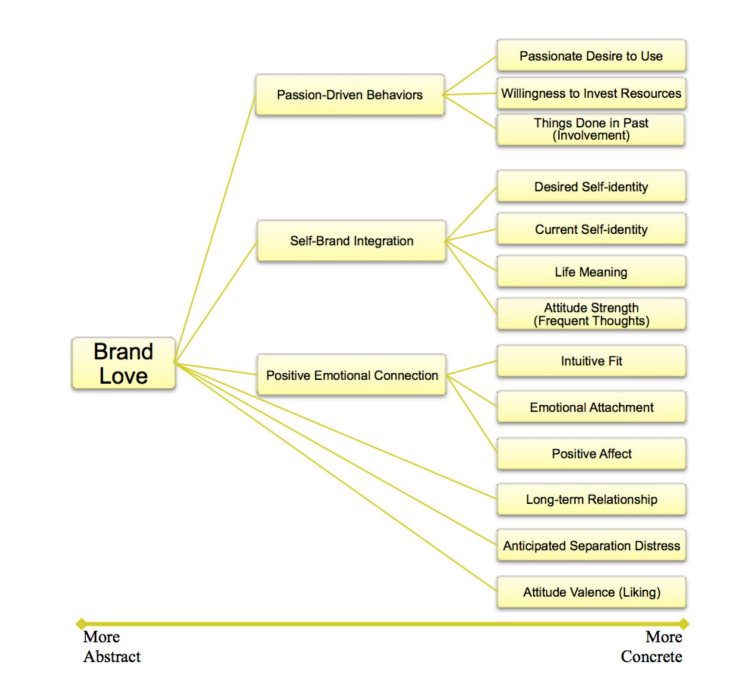
The following chapter is related to the research methodology of the study.
CHAPTER THREE: RESEARCH METHODOLOGY
Research methodology is an essential part of the research.
Introduction
Research methodology is useful in understanding the structure of the study and the methods and techniques applied to enable the researcher to generate the results. The research methodology is inclusive of research philosophy, research design, sample size, sampling techniques, data collection tool, and data collection methods and data analysis. At the end of the study ethical considerations and limitations are discussed.
Research Philosophy
According to Edson, Henning and Sankaran (2016), research philosophy is designed as the philosophical framework taking into consideration the subjective reality of the research study. There are different types of research philosophies including interpretivism, positivism and realism. The research philosophy is also categorized as a research paradigm. Interpretivism involves maximum participation of the individuals.
The following study is based on the positivism approach. This study was based on a survey questionnaire and quantitative analysis.
Research Approach
According to Savin-Baden and Major (2013), there are two types of research approaches namely inductive and deductive research approaches. In the inductive approach, the data is gathered from interviews with the participants and is inclusive of their past experiences.
The inductive approach enables the researcher to understand the theories and concepts related to a specific phenomenon and generate a theory based on the analysis. The theory assists the researcher in the development of the hypothesis.
However, the deductive approach is based on the evaluation of the existing theories based on the past literature. The hypothesis is formulated based on the past data. The deductive approach is generated based on the generation of a hypothesis and testing it through the application of statistical analysis.
In this research, the deductive approach was utilized to generate statistical facts and figures about brand love and its association with dietary supplements in the FMCG industry.
Research Design
It is essential to develop a research design so that the researcher easily categorizes the data collection process. According to Creswell (2013), there are three types of research designs qualitative research, quantitative research design and mixed-method design.
The qualitative research design is associated with the collection of data from the participants through the conduct of detailed interviews. The tool used to collect the data is the open-ended questionnaire. The qualitative data cannot be quantified.
Qualitative research design is involved in the collection of data that is based on the analysis of detailed interviews with the participants.
The quantitative research design on the contrary is based on numeric data. The collected data is analysed through statistical software and the application of various tests and techniques (Creswell 2013). The data is then presented in graphical and tabular forms.
The data collected for this study was based on both qualitative and quantitative research designs. The qualitative data was collected to analyse the response of the respondents while the quantitative data was collected to generate statistical figures.
Thus the research design for the study herein was the quantitative research design. Mixed method research is more beneficial as compared to qualitative and quantitative because the data gathered is rich in context and it becomes easier to accomplish the objective of the research and encounter the research problem easily.
Data Collection Method
According to Wright et al., (2016: 2230) there are two types of data collection including primary and secondary data collection. The primary data collection includes the data from the sources as detailed interviews with the participants, focus groups and surveys. The primary data is collected by the researcher himself. The data is in its raw form, not published before.
The researcher performs tests and experiments to generate results or perform thematic analysis based on the interviews collected from the participants. The other type of data collection includes secondary data collection in which data is collected from secondary sources.
The data is gathered from newspapers, articles, websites, and journals and the work of past researchers is acknowledged through proper referencing. Secondary data collection is based on the already existing research and the researcher collects the data to develop a clear understanding of the past data.
For this study, the researcher collected the data from both the sources including primary by interviewing and survey collection from male and female participants living in the UK aged between 16 to 35 years. The data was also collected from secondary resources to conduct an analysis and develop an understanding of brand love from past researchers.
Sampling Method
According to Trayer and Kohn (2017: 32), sampling methods are used to enable the researcher to recognize and recruit respondents for the study. The data gathered from these respondents represents the overall target population. The complete population is difficult to analyse due to the cost and time constraints. The sampling methods are classified as probability sampling and non-probability sampling methods.
The probability sampling technique is defined as the data collection process where the respondents have an equal opportunity to be selected. There are different types of probability sampling techniques including simple random sampling technique, systematic random sampling and many others.
The random sampling techniques involve the collection of data randomly with each participant having an equal opportunity of being selected. Cluster random sampling is another form of probability sampling technique involving the collection of data in clusters and then selecting the sample size from the clusters.
According to Riley et al., (2014), the non-probability sampling technique does not provide an equal opportunity for the respondents to be equally selected. Convenience sampling and snowball sampling are types of non-probability sampling techniques. In a convenient sampling technique, the researcher collects the data based on the accessibility and availability options.
The following study involved the collection of the data through a convenience sampling technique which was completed in a two-month duration time frame. The researcher gathered the data based on convenience and under his available budget constraints.
Sample Size
The data was collected from a sample of two hundred individuals living in the United Kingdom. The individuals were aged between 16 to 35 years. For this purpose, a survey questionnaire was designed based on 13-15 close-ended questions which would be conducted by the consumers of the UK who consume Opti-Turmeric as their dietary supplement.
Data Analysis Technique
According to Twisk (2013), data analysis is one of the most important parts of the study. Several tools and techniques are used to analyse the data and determine the association between the dependent and independent variables. The data collected through this study were analysed using statistical software namely SPSS. The results generated through the SPSS were represented graphically in the form of tables and charts.
Triangulation
According to Carter et al., (2014), the data was collected from qualitative and quantitative research design thus it was necessary to triangulate the data to visualize the definitive measurements as provided by the data. This process enabled the researcher to understand how long-term brand loyalty in the different consumer segments may be established in the best way.
The final aspect of the analysis was shown in chapter four including the data analysis and representation showing a relation to the existing state of knowledge in this field.
Ethical Considerations
Carrying out research in an effective way requires it to follow ethical considerations and principles. The study adopted the data from the primary as well as the secondary resources. The data collected from the participants were after the consent from the participants. They were assured that the data was used only for the study. The secondary data collected from the secondary sources were properly referenced to acknowledge the work of the past researchers.
Research Limitations
Every researcher faces limitations during the study. One limitation of the research was the external validity. The scope of the study was limited and cannot be generalized. Due to the budget and time constraints, the researcher collected the data from the primary sources based on his convenience and accessibility. Human error is something that cannot be mitigated. The sample size was short due to the limited time frame and budget constraints.
Connect With Writer Now
Discuss your requirements with our writers for research assignments, essays, and dissertations.
-
Factors Affecting Brand Love
The factors affecting brand love include the following:
1. Variety Seeking
According to Unal and Aydin (2013: 76), customers look for changes in their lives. There exists an association between variety-seeking and brand love. When the customers have many options related to a brand or a brand or product, more chances are that the consumers switch the brand. This variable is associated with brand love.
2. Brand Image
Brand image is the perception that is as a whole perspective and subjective. The brand image develops an image of the “personality” or product users for any specific product. The brand image is developed as an impression in the minds of consumers when they receive information related to the brand from different resources.
A study was conducted to evaluate the impact of brand image on perceived value, satisfaction and loyalty. The results showed that brand image was positively associated with these variables. The literature on brand love was found to be scarce (Mohammadian and Karimpour 2014).
3. Social-Self
Brands that appeal to the inner and social self are considered reflective of the self. A study was conducted showing the relationship between social self and brand. It was found that the love for the brands reflective of their identity appeared to be higher. When the brand represents personal identity, then the chances of positive word-of-mouth communications also increase.
4. Brand Loyalty
When a consumer loves a brand, he/she will also stay loyal and committed to the brand whenever they go shopping. The more times, a brand is purchased by the consumer, the strength and loyalty towards that brand increases. Brand loyalty increases over time.
When consumers have a feeling of satisfaction and love towards the brand the number of purchases is likely to increase (Mohammadian and Karimpour 2014:94).
5. Positive Word of Mouth Communications
Positive word of communication represents the positive discourses and affection shown by the consumers towards a brand. According to the study conducted, brand love was associated with positive word-of-mouth communications. When the consumers are satisfied related to a product, the chances are that there is more chance that they spread positive word-of-mouth communications.
-
Factors Associated with Consumer Buying Behaviour
According to Albert and Merunka (2013: 258), several factors influence the behaviour of the individual to purchase a product and their association with brand love. The factors include social, cultural, personal and psychological.
The social factors are associated with the influence of family, reference groups and the roles and the consumer’s status. Based on social circles, consumers develop preferences to buy a product.
The cultural variables include culture, subculture and social class. The consumer gets attracted to a variety of brands stays loyal to them and develops intentions to purchase them. The personal factors affecting consumer buying behaviour include the age and life cycle stages, occupation, income and lifestyle variables and personality.
The consumer is greatly affected by these factors. The fourth factor affecting consumer buying behaviour includes the psychological variables including motivation, perceptions, learning, beliefs and attitudes.
-
Measuring Brand Love by Scales
In the light of Carroll and Ahuvia (2006), the authors proposed a brand love scale which is composed of ten different items which are reflected in determining the unique dimensions of brand love. The items which are used to measure brand love for a particular brand are also presented in the questionnaire of this research. However, the items on which the brand love is measured in explained in the table below:
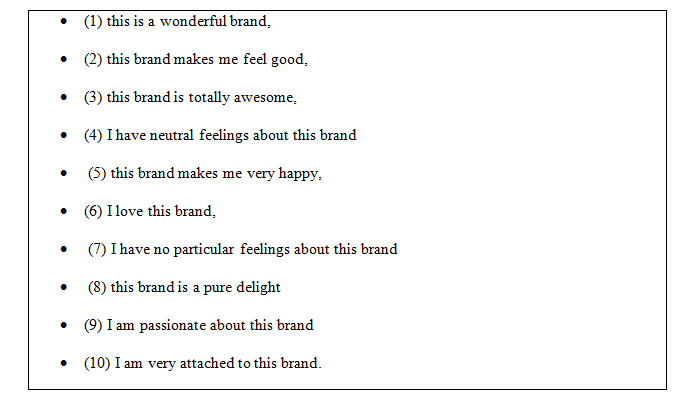
-
Research Hypothesis
The research hypothesis for the study here includes the following:
H1: There is an impact of brand love on consumer buying behaviour.
H0: There is no impact of brand love on consumer buying behaviour.
-
Conceptual Framework
The conceptual framework is based on the factors associated with brand love including variety seeking, brand image, social self, brand loyalty and word-of-mouth communications.

Figure 1: Conceptual Model
Guaranteed AI-Free Work
Protect your degree from AI-Objectifying! Get 100% human generated research content!
CHAPTER 4: DATA ANALYSIS
This chapter focuses on analysing the data which is collected by the previous chapter.
Introduction
With the help of efficient, effective and comprehensive data analysis it can be ensured that the results and findings of the research are relevant. To analyse the data systematically, several different techniques are used by the researcher.
The data was collected with the help of survey questions from 200 respondents residing in the region of the UK. The data obtained from the research questionnaire was then evaluated with the help of the statistical software SPSS. This research has used correlation analysis, regression analysis and descriptive analysis to analyse the data collected for the research efficiently.
Correlation Analysis
The primary aim of applying correlation analysis is to find out the relationship that may exist between two or more variables. There are several different statistical software with the help of which correlation analysis can be tested, the most popular among all is SPSS.
The correlation analysis is conducted to know about the relationship that exists between the independent and dependent variables of the research. The independent variable of this research is brand love while the dependent variable is consumer buying behaviour. The relationship between both these variables is tested out for the dietary supplements sector.
Website Attributes on Consumer Buying Pattern
The results of the correlation test are shown in the tabular form below:
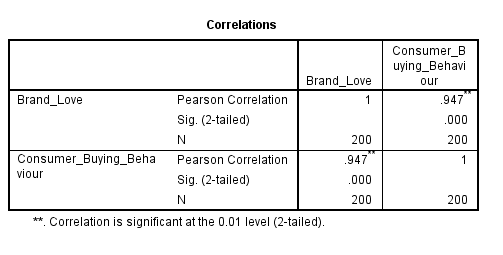
The table depicts certain values which are of great importance to analysing and evaluating the data of correlation analysis. The Pearson correlation value is the value that shows the strength of the relationship that exists among two variables.
The other important value to be considered is the sig value which shows the level of significance among the relationship between two variables of the research.
To prove that the relationship between the variables is significant, the significant value must be less than the alpha value of 0.05. As for the results of this table, the value of Pearson correlation value is 0.947 which shows that there is a strong correlation among both the variables of the research. It can be said that there is a 94.7% correlation among both the variables of the research.
The significance value for this correlation analysis is 0.000 which is less than the alpha value of 0.05. This means that the relationship between brand love and consumer buying behaviour is significant.
By looking at the correlation test conducted for this particular research, it can be seen that there is a significant relationship that exists between brand love and consumer buying behaviour.
This statement can be verified with the help of prior research done in this regard. This can be identified by the research conducted by Rageh Ismaili and Spinelli (2012: 386) according to which there is a relationship between brand love with consumer buying behaviour.
Moreover, this relationship can also be verified with the significance value which is less than 0.05 this means that the relationship between brand love and consumer buying behaviour is significant.
Regression Analysis
Another important test that is conducted for this particular research is regression analysis. Regression analysis is carried out to know about the impact of the independent variable on the dependent variable.
For this particular research regression analysis is carried out by the researcher to find out the impact of brand love on consumer buying behaviour in the dietary supplement sector in the UK.
It can also be said that the regression analysis is to know about the variance which is caused by the independent variable on the dependent variable.
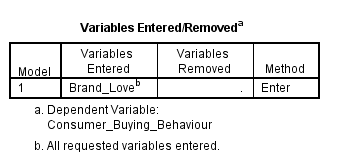
The above table is the representation of variables that are entered or removed in the test conducted for this research. As it is clear from the table above all the variables of the research are entered for this specific test and none of the variables is removed. This shows that the results obtained for the regression analysis are significant and authentic.
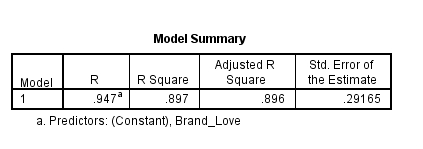
This table is used to predict the correlation among the variables of the research as well as to determine variance which may have been caused by the independent variable on the dependent variable. The R-value in the above table shows the interdependence or interrelationship among the variables of the research, for this research the R-value is 0.947 which means that there is 94.7% interdependence among the variables of the research.
The other value in the table is that of R square which depicts the extent to which the independent variable can predict the value of the dependent variable. For this research, the value of R square is 0.897 which means that brand love can predict the value of consumer behaviour to 89.7%.
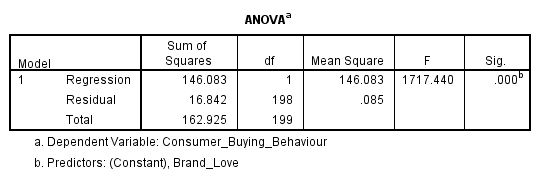
ANOVA is an abbreviation for Analysis of Variance; it aims to show the fitness of the model of the research. There are two important values in the table of ANOVA; F value and sig value. The greater value of F shows that the fitness of the model is high and the sig value is used to find the significance of the model which is used for the research.
For this research, the F value is 1717.440 which is quite large and hence it shows that the fitness of the model is extremely high. On the other hand, the significance value is 0.000 which is less than 0.05 hence the model used for this research is significant.

The table above shows the coefficients of the research, it shows the significance of the independent variable over the dependent variable with the help of sig value.
Another important value in this table is the Beta value of unstandardized coefficients this shows the change in the independent variable caused by the change in the dependent variable of the research.
It is evident from the above table that the significance value of both variables of the research which are brand love and consumer buying behaviour is 0.000 which is less than 0.05 which means that the impact of brand love on consumer buying behaviour is significant.
The findings of this research are in alignment with the findings of research conducted by Carroll and Ahuvia (2006, p. 79) which showed that there is a significant impact of brand love on consumer buying behaviour.
Following text related to descriptive analysis.
-
Descriptive Analysis
To analyse the data collected with the help of the questionnaire, descriptive analysis was conducted.
Brand Love
The descriptive analysis is carried out separately for all the questions of the questionnaire to compare and contrast the statistics of the survey questionnaire. The descriptive analysis for this research is shown below
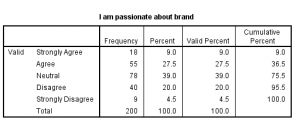
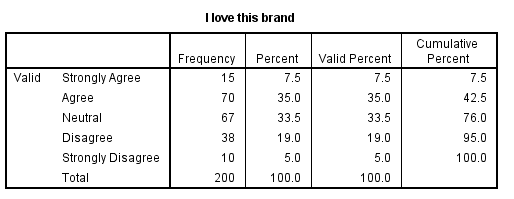
The first question which was asked the respondents was about how passionate they were about the brand of dietary supplements. The results show that a total of 75 respondents out of 200 respondents agreed and strongly agreed that they are passionate about the particular brand.
However, out of 200, 49 of the total respondents disagreed and strongly disagreed in this regard. The remaining respondents were neutral about this statement. The table above also shows that 20% of respondents disagreed with the statement.
This can be linked with the literature that some individuals do not prefer to use brands and they are not passionate about them. Respondents who are neutral to the statement are those who believe that the brands are important only to a certain extent and that they are not passionate about it.
However, 9 individuals have disagreed about brands of dietary supplements. This shows that individuals are not attracted to any brand of dietary supplements unless it offers them anything great in value.
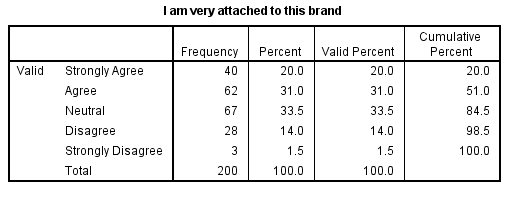
The next question which was asked from the respondents was about their attachment to the brand of Dietary supplements. The results show that a total of 82 respondents out of 200 respondents agreed and strongly agreed that they are attached to the particular brand.
However, out of 200, 31 of the total respondents disagreed and strongly disagreed in this regard. The remaining respondents were neutral about this statement.
Optitumeric is a well-known brand in the UK and respondents who agree that they are highly attached to this brand seem to have developed some kind of association with it due to which they love the brand.
Optitumeric is one of the most selling dietary supplements in the UK due to which respondents prefer to use it because of its name.
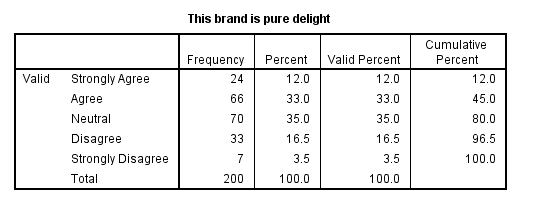
Furthermore, the respondents were asked if they perceive the brand of dietary supplements to delight them. The results show that a total of 90 respondents out of 200 respondents agreed and strongly agreed that they are delighted with the particular brand.
However, out of 200, 40 of the total respondents disagreed and strongly disagreed in this regard. The remaining respondents were neutral about this statement. Respondents who have agreed with the above statement depict that Optitumeric is an awesome brand of UK which caters to all dietary needs of individuals along is easily consumed.
Moreover, the table above also shows that some of the respondents have disagreed with this statement which means that they believe that Optitumeric is not able to cater to their health dietary needs. Individuals who have shown a neutral response may have not consumed the supplements or are attracted to other dietary supplement brands.

Next, the respondents were asked about the brand being awesome in their perception. The results show that a total of 91 respondents out of 200 respondents agreed and strongly agreed that they consider the particular brand of dietary supplements to be awesome.
However, out of 200, 39 of the total respondents disagreed and strongly disagreed in this regard. The remaining respondents were neutral about this statement.
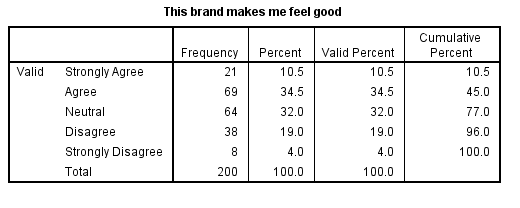
Furthermore, the respondents were asked about how they felt after using the particular brand of dietary supplements. The results show that a total of 90 respondents out of 200 respondents agreed and strongly agreed that they consider the particular brand of dietary supplements to make them feel good.
However, out of 200, 46 of the total respondents disagreed and strongly disagreed in this regard.
The remaining respondents were neutral about this statement. The table above also shows whether optitumeric makes the respondents feel good about their health or not.
When a brand makes a consumer feel good this means that it must have provided some value-added service to them. In addition to this, 19% of respondents disagreed with the statement because they might feel that dietary supplements cannot make them feel good in any way since they have a misconception about it.
Respondents who have agreed with this statement must have had a good experience with the brand like they might have felt the physical change in their body instantly after consuming for a few days.
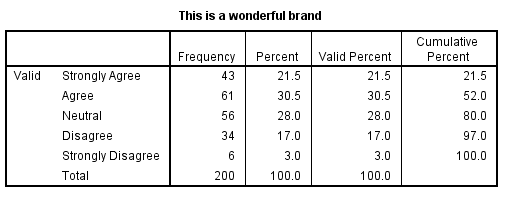
This question focused on asking the respondents how wonderful they consider the particular brand of dietary supplements. The results show that a total of 84 respondents out of 200 respondents agreed and strongly agreed that they consider the particular brand of dietary supplements to be a wonderful brand. However, out of 200, 40 of the total respondents disagreed and strongly disagreed in this regard.
The remaining respondents were neutral about this statement. In addition to the above analysis, Optitumeric is a dietary supplement brand that is recognized in the UK however, respondents who do not agree with the above statement must have experienced something bad or must have heard some negative views about it.
The last question regarding brand love focused on asking the respondents how happy they feel while using a particular brand of dietary supplements.
The results show that a total of 95 respondents out of 200 respondents agreed and strongly agreed that they consider the particular brand of dietary supplements to make them feel happy.
However, out of 200, 30 of the total respondents disagreed and strongly disagreed in this regard. The remaining respondents were neutral about this statement.
Consumer Buying Behaviour

The first question regarding consumer buying behaviour which was asked from the respondents was if the purchase of the particular brand reflects the person which they want to be. The results show that a total of 104 respondents out of 200 respondents agreed and strongly agreed that purchasing this particular brand does reflect the person they want to become.
This clearly shows that the majority of consumers tend to buy a particular product as it reflects the type of person they are. The results are from the research conducted by Freling and Forbes (2013).
However, out of 200, 29 of the total respondents disagreed and strongly disagreed in this regard. This means that certain respondents do not consider that there is an impact of personality reflection on consumer purchase and buying behaviour. The remaining respondents were neutral about this statement.

The next question which was asked from the respondents was regarding purchasing a brand that facilitates them in terms of self-identity. The results show that a total of 107 respondents out of 200 respondents agreed and strongly agreed that purchasing this particular brand facilitates the communication of their self-identity.
This shows that self-identity is an important factor for several people which also shapes their consumer purchase decision. This stance complies with the concept of “who you are affecting what you buy” (Ilaw 2014).
However, out of 200, 33 of the total respondents disagreed and strongly disagreed in this regard. This means that certain respondents do not consider that their self-identity is an important factor in shaping their purchase decisions. The remaining respondents were neutral about this statement.

The next question which was asked from the respondents was if purchasing a specific brand helps in express themselves. The results show that a total of 100 respondents out of 200 respondents agreed and strongly agreed that purchasing this particular brand facilitates expressing themselves.
The results clearly show that the majority of the respondents feel that the purchase of Opti-turmeric helps them to express themselves. This means that this particular brand is efficient and well-suited for them to express themselves as compared to other substitutes available in the market. However, out of 200, 30 of the total respondents disagreed and strongly disagreed in this regard.
The respondents who responded to this question in disagreement meant that the purchase of this specific brand of dietary supplement had nothing to do with their expression. It should be noted that the respondents in this category are much less than the respondents who agreed and strongly agreed to the statement. The remaining respondents were neutral about this statement.

The next question which was asked from the respondents was about the social symbol connection with consumer buying behaviour. The results show that a total of 108 respondents out of 200 respondents agreed and strongly agreed in this regard.
The majority of the respondents agreed with the statement that they use this specific brand as it is a social symbol. This can be justified as Opti-Turmeric is one of the highest-selling supplements.
This supplement is different and much better in quality as compared to other cheaper substitutes in the market. Hence some people consume these supplements as they add to their social status.
However, out of 200, 24 of the total respondents disagreed and strongly disagreed in this regard. The people who had disagreed in this regard are fewer in number as compared to the people who have agreed and strongly agreed with the statement.
Irrespective of the number of respondents, the people who disagreed show that these are the people who do not merely consume Opti-Turmeric for social status. The remaining respondents were neutral about this statement.

The next question which was asked from the respondents was about consumer buying behaviour regarding fitting in social situations.
The results show that a total of 150 respondents out of 200 respondents agreed and strongly agreed in this regard. However, out of 200, 12 of the total respondents disagreed and strongly disagreed in this regard. The remaining respondents were neutral about this statement.

Furthermore, the respondents were asked if they like to be seen as associated with a specific brand.
The results show that a total of 143 respondents out of 200 respondents agreed and strongly agreed in this regard. However, out of 200, 13 of the total respondents disagreed and strongly disagreed in this regard. The remaining respondents were neutral about this statement.

The next question which was asked from the respondents was about the reliance on purchase on impulse. The results show that a total of 145 respondents out of 200 respondents agreed and strongly agreed in this regard. However, out of 200, 55 of the total respondents disagreed and strongly disagreed in this regard. The remaining respondents were neutral about this statement.

The last question which was asked was about the impact of brand love on consumer buying behaviour. The results show that a total of 151 respondents out of 200 respondents agreed and strongly agreed in this regard.
This shows that the respondents who purchase Opti-Turmeric as a dietary supplement are because of their love for the specific brand. The results of this question also align with the correlation and regression analysis of this research which clearly showed that there is a strong relationship between brand love and consumer purchase decision.
However, out of 200, 49 of the total respondents disagreed and strongly disagreed in this regard. The remaining respondents were neutral about this statement.
-
Discussion
For this section, the researcher has reflected on the brand love scales which are the main construct in the measurement of brand love. Moreover, the research questions are briefly discussed in this chapter which is successfully answered by the researcher throughout this research.
The first questions in this research ask about the basic understanding of the concept of brand love and consumer buying behaviour.
However, this research question was successfully answered by the researcher by reviewing different theoretical perspectives and concepts as given by the previous researchers.
Upon viewing different concepts and theories, it was identified that brand love was considered an emerging concept and needs to be explored. It closely impacts the purchasing behaviour of the consumer.
Due to the increasing number of brands, the consumers were found switching from one brand to another and the increased ageing and healthcare costs were demanding dietary supplements that appeared nutritious in context.
Those brands that provided quality were found preferred by the consumers and organizations were competing to gain market share. The researcher also identified from the research conducted in the field of brand love that it is based on the interpersonal relationship between the brands and the consumers as to how the customers get attached to a particular brand.
The basic understanding of brand love was identified from the notion of brand desire, the emotional appeal of the brand and the impulsive desire of the brand which creates a psychological impact on the consumers. The psychological impact created by brand love helps the customers in formulating their buying behaviour.
Brand love is based on the notion of how the individual interacts with the emotional appeal of the brand. The love of the products and brands from the consumer’s perspective is quite a popular research topic that aims to measure the love feeling of the consumers towards a particular brand. This can lead to a better understanding of that particular brand of the love construct which is of more relevance from the managerial perspective.
The second question of the research is based on highlighting the factors which are associated with brand love and consumer buying behaviour. This research question was also addressed by the research through viewing certain concepts and theories which were directed towards explaining the factors related to brand love and buying behaviour of the consumers
-
Hypotheses Assessment
| S. No | Hypotheses Assessment | Sig. Value |
| 1 | There is an impact of Brand love on Consumer Buying Behaviour |
0.000 (Accepted) |
The table above represents the assessment of the hypotheses of the statement which states that there is a significant impact of Brand love on consumer buying behaviour. The sig. value is 0.000 which reflects that the alternative hypotheses are accepted in this case.
Guaranteed Plagiarism-Free Work
Get 100% human generated plagiarism-free research content from our expert writers!
CHAPTER 5: CONCLUSION AND RECOMMENDATIONS
The chapter would include the summary and findings of the research.
-
Introduction
The introductory chapter also includes the conclusion of the research conducted. The chapter would include recommendations on how brands can enhance their customer satisfaction.
The recommendations and future implications are present in this study on the other hand the limitations of the study were met by the researcher. At the end of the chapter, the researcher will include a discussion of the results.
-
Summarized Findings
The summarized findings of the research show that there is a strong relationship between brand love and consumer buying behaviour. The findings were analysed with the help of correlation and regression.
Descriptive statistics were also conducted on the questions asked by respondents. The Pearson correlation of the study shows that both the independent and dependent variable has a strong relationship.
Brand love is the association of any consumer with the brand. The brand love of consumers shows that consumers give first preference to the brand in purchasing them and that they do not compare the brand with any other existing competitor.
The results have displayed that consumers love the dietary supplements sector and they are not ready to compromise with any other brand. The results also show that consumers have a strong inclination towards the brand due to which consumer buying behaviour does not alter.
The results of correlation and regression show that there is a strong relationship between both variables. Consumer buying behaviour can be described as the behaviour of consumers while purchasing brands. After the research was tested, it was found that consumers show a preference for those brands which offer them better services and satisfy their needs.
Furthermore, the descriptive analysis in the previous chapter shows how consumers have responded to brand love and its traits. The questions asked by consumers were related to their likes or dislikes towards the brand.
The questions also show that consumers love the brand and most importantly they have answered in the range agreeing with the statement.
Furthermore, consumer behaviour and brand love show that there is a strong relationship between both variables concerning the dietary supplements, the consumers use more of the brands since it is beneficial for their health and due to the increased amount of awareness and marketing, they purchase it more.
-
Recommendations
To cater for the identified research gap in this study, the following recommendations are made:
- Dietary supplements can start their advertisement and promotional campaign to attract customers.
- The industry can try to interact with its customers through outdoor activities.
- Furthermore, to increase brand love among consumers, brands can increase their association with consumers.
-
Conclusion
To sum up the whole research study, it can be analysed that brand love has a strong relationship with consumer buying behaviour concerning the dietary supplement industry. The brand love of consumers can be linked with the choices and preferences of consumers.
Moreover, the study and analysis have shown that there is a strong relationship between both variables. The analysis also shows that consumers are inclined towards those brands which offer them great services.
The research gap was identified in this study and following that the solution was determined. The data analysis and summary findings are presented to recommend solutions to dietary supplements.
The research study has been useful in understanding the concepts of brand love and consumer buying behaviour. The change in consumers’ attitudes towards the brand offerings has been understood.
Furthermore, the study has shown that consumer buying behaviour and brand love have a strong association with each other; the study has also shown that both variables have a strong relationship.
Consumers use more of the brands since it is beneficial for their health and due to the increased amount of awareness and marketing, they purchase it more.
Connect With Writer Now
Discuss your requirements with our writers for research assignments, essays, and dissertations.
REFERENCES
Albert, N., & Merunka, D. (2013). The role of brand love in consumer-brand relationships. Journal of Consumer Marketing, 30(3), 258-266.
Anderson, J. W. (2016). Sternberg's Triangular Theory of Love. The Wiley Blackwell Encyclopedia of Family Studies.
Caroll, B. A., Ahuvia, A. C., 2006. Some antecedents and outcomes of brand love. Marketing Letters 17, 79-89.
Carroll, B.A. and Ahuvia, A.C., 2006. Some antecedents and outcomes of brand love. Marketing letters, 17(2), pp.79-89.
Carter, N., Bryant-Lukosius, D., DiCenso, A., Blythe, J., and Neville, A. J. (2014, September). The use of triangulation in qualitative research. In Oncology nursing forum (Vol. 41, No. 5).
Cheein, F. A. (2016). Intelligent Sampling Technique for Path Tracking Controllers. IEEE Transactions on Control Systems Technology, 24(2), 747-755.
Creswell, J. W. (2013). Research design: Qualitative, quantitative, and mixed methods approaches. Sage publications.
Creswell, J. W. (2013). Research design: Qualitative, quantitative, and mixed methods approaches. Sage publications.
Drennan, J., Bianchi, C., Cacho-Elizondo, S., Louriero, S., Guibert, N., and Proud, W. (2015). Examining the role of wine brand love on brand loyalty: A multi-country comparison. International Journal of Hospitality Management, 49, 47-55.
Drennan, J., Bianchi, C., Cacho-Elizondo, S., Louriero, S., Guibert, N., and Proud, W. (2015). Examining the role of wine brand love on brand loyalty: A multi-country comparison. International Journal of Hospitality Management, 49, 47-55.
Dunn, L., and Hoegg, J. (2014). The impact of fear on emotional brand attachment. Journal of Consumer Research, 41(1), 152-168.
Dwivedi, A. (2015). A higher-order model of consumer brand engagement and its impact on loyalty intentions. Journal of Retailing and Consumer Services, 24, 100-109.
Edson, M. C., Henning, P. B., and Sankaran, S. (Eds.). (2016). A guide to systems research: Philosophy, processes and practice (Vol. 10). Springer.
FDA Administration (2017) [U.S Food and Drug [Online] Available from https://www.fda.gov/AboutFDA/Transparency/Basics/ucm195635.htm][28 April 2017]
Ilaw, M. A. (2014). Who You Are Affects What You Buy: The Influence of Consumer Identity on Brand Preferences. Elon Journal of Undergraduate Research in Communications, 5(2).
Japutra, A., Ekinci, Y., and Simkin, L. (2014). Exploring brand attachment, its determinants and outcomes. Journal of Strategic Marketing, 22(7), 616-630.
Karjaluoto, H., Karjaluoto, H., Munnukka, J., Munnukka, J., Kiuru, K., and Kiuru, K. (2016). Brand love and positive word of mouth: the moderating effects of experience and price. Journal of Product and Brand Management, 25(6), 527-537.
Kemp, E., Jillapalli, R., & Becerra, E. (2014). Healthcare branding: developing emotionally based consumer brand relationships. Journal of Services Marketing, 28(2), 126-137.
Kiuru, K. (2014). The relationship between brand love and positive word of mouth.
Kiuru, K. (2014). The relationship between brand love and positive word of mouth.
McAdam, M., McAdam, R., Dunn, A. and McCall, C., 2014. Development of small and medium-sized enterprise horizontal innovation networks: UK agri-food sector study. International Small Business Journal, 32(7), pp.830-853.
Mende, M., Scott, M. L., Lemon, K. N., & Thompson, S. A. (2015). THIS BRAND IS JUST NOT THAT INTO YOU Exploring the role of firm integrity in how consumers react to customer firing. Strong Brands, Strong Relationships.
Mohammadian, M., and Karimpour, Y. (2014). Identifying the factors influencing the feeling of love toward a brand: the Adidas case. Switzerland Research Park Journal, 103(1), 94-122.
Pucciarelli, F., & Kaplan, A. (2016). Competition and strategy in higher education: Managing complexity and uncertainty. Business Horizons, 59(3), 311-320.
Rageh Ismail, A., & Spinelli, G. (2012). Effects of brand love, personality and image on word of mouth: The case of fashion brands among young consumers. Journal of Fashion Marketing and Management: An International Journal, 16(4), 386-398.
Research and Markets (2017) [UK vitamin and dietary supplements demand and forecast [online] Available from http://www.researchandmarkets.com/reports/1883515/the_uk_vitamin_and_dietary_supplements_demand_and.pdf][28 April 2017]
Riley, W., Hays, R. D., Kaplan, R. M., and Cella, D. (2014). Sources of comparability between probability sample estimates and nonprobability web sample estimates. In Proceedings of the 2013 Federal Committee on Statistical Methodology (FCSM) research conference.
Roy, S. K., Eshghi, A., and Sarkar, A. (2013). Antecedents and consequences of brand love. Journal of Brand Management, 20(4), 325-332.
Sarkar, A. (2014). Brand love in an emerging market: a qualitative investigation. Qualitative Market Research: An International Journal, 17(4), 481-494.
Savin-Baden, M., and Major, C. H. (2013). Qualitative research: The essential guide to theory and practice. Routledge.
Scherer, A. G., Palazzo, G., & Seidl, D. (2013). Managing legitimacy in complex and heterogeneous environments: Sustainable development in a globalized world. Journal of Management Studies, 50(2), 259-284.
Schmitt, B. H., Brakus, J., and Zarantonello, L. (2014). The current state and future of brand experience. Journal of Brand Management, 21(9), 727-733.
Solomon, M. R. (2014). Consumer behaviour: Buying, having, and being (Vol. 10). Englewood Cliffs, NJ: Prentice Hall.
Thakur, S., & Aurora, R. (2015). Consumer Preferences change when it comes to green Marketing. Marketing, 245-255.
Trayler, R. B., and Kohn, M. J. (2017). Tooth enamel maturation reequilibrates oxygen isotope compositions and supports simple sampling methods. Geochimica et Cosmochimica Acta, 198, 32-47.
Twisk, J. W. (2013). Applied longitudinal data analysis for epidemiology: a practical guide. Cambridge University Press.
Unal, S., and Aydın, H. (2013). An investigation on the evaluation of the factors affecting brand love. Procedia-Social and Behavioral Sciences, 92, 76-85.
Vanelslander, T., Deketele, L., and Van Hove, D. (2013). Commonly used e-commerce supply chains for fast-moving consumer goods: comparison and suggestions for improvement. International Journal of Logistics Research and Applications, 16(3), 243-256.
Wilkinson, C. R., & De Angeli, A. (2014). Applying user-centred and participatory design approaches to commercial product development. Design Studies, 35(6), 614-631.
Wright, A. L., Wahoush, O., Ballantyne, M., Gabel, C., and Jack, S. M. (2016). Qualitative Health Research Involving Indigenous Peoples: Culturally Appropriate Data Collection Methods. The Qualitative Report, 21(12), 2230-2245.
APPENDIX
-
Questionnaire
Demographics
Gender
- Male
- Female
Age
- 18-23
- 24-30
- 31-36
- 37-43
- More than 43
Average Income (monthly, in US dollars)
- 2500-3500
- 3501-4500
- 4501-5500
- 5501-6500
- More than 6500
| Strongly Agree | Agree | Neutral | Disagree | Strongly Disagree | |
| Brand love (Independent variable) | |||||
| I am passionate about the brand | |||||
| I love this brand | |||||
| I am very attached to this brand | |||||
| This brand is a pure delight | |||||
| This brand is awesome | |||||
| This brand makes me feel good | |||||
| This is a wonderful brand | |||||
| This brand makes me feel very happy | |||||
| Consumer buying behaviour (dependent variable) | |||||
| I purchase a brand that reflects the type of person I see myself to be. | |||||
| I purchased a brand that facilitates me to communicate with my self-identity. | |||||
| I purchased a brand that helps me to express myself. | |||||
| I like brands that depict symbols of social status. | |||||
| I prefer a brand that helps me to fit important social situations. | |||||
| I like to be associated with this specific brand. | |||||
| I like to plan my purchases rather than relying on impulse. | |||||
| There is an impact of brand love on consumer buying |
Get 3+ Free Custom Topics within 24 hours;
Get an Immediate Response
Discuss your custom requirements with our writers
Free Online Plagiarism Checker For Students
We will email you the report within 24 hours.
Upload your file for free plagiarism



























